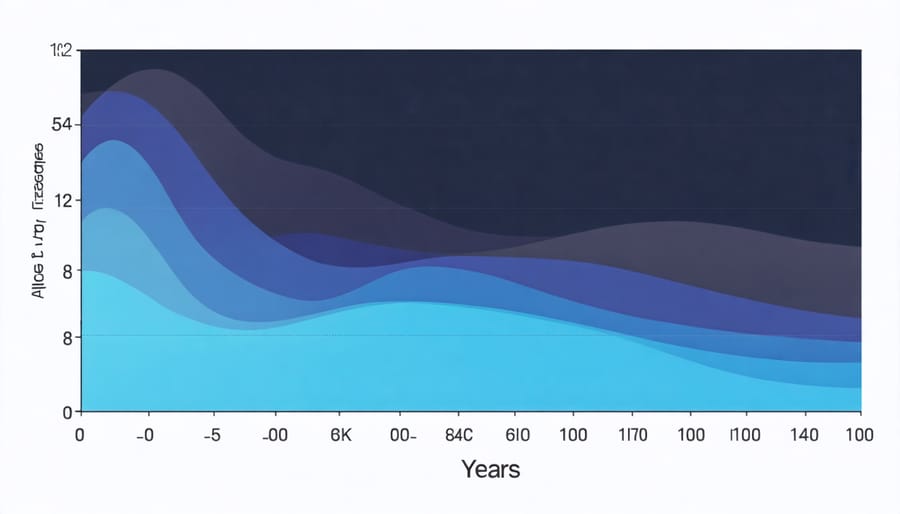Challenging the long-held belief that metabolism remains constant throughout life, groundbreaking research reveals a more complex reality. Our metabolic rate actually shifts significantly during key life stages, influenced by factors ranging from hormonal changes to lifestyle choices. Understanding these fluctuations has revolutionized approaches to personalized nutrition and health management. Recent studies from the Canadian Medical Association show that metabolic rates peak in our 20s, stabilize through middle age, and gradually decline by approximately 2% per decade after age 40. This natural progression, while universal, can be actively managed through targeted nutrition and exercise strategies. Whether you’re an athlete focused on performance or someone managing weight, recognizing these metabolic changes is crucial for developing effective, age-appropriate health strategies that evolve with your body’s changing needs.
The Science Behind Your Changing Metabolism
Age-Related Metabolic Changes
Contrary to popular belief, our metabolism does naturally change as we age. Research shows that metabolic rate typically peaks in our 20s and gradually declines by 2-3% per decade after that. This change occurs due to several factors, including the natural loss of muscle mass, hormonal shifts, and decreased physical activity levels.
During our 30s and 40s, we may notice subtle changes in how our bodies process nutrients and store energy. These changes become more pronounced in our 50s and beyond, as our cells become less efficient at producing energy from the food we eat. However, this doesn’t mean metabolic decline is inevitable or unchangeable.
The good news is that we can influence these age-related changes through lifestyle choices. Regular strength training helps maintain muscle mass, which is crucial for maintaining a healthy metabolic rate. Staying physically active, getting adequate sleep, and maintaining proper nutrition can help minimize the natural slowdown in metabolism.
Understanding these natural changes allows us to make informed decisions about our diet and exercise routines, adapting them as we age to support optimal metabolic health.

Lifestyle Impact on Metabolic Rate
Your metabolism isn’t set in stone – it’s actually quite responsive to your lifestyle choices. Research shows how daily habits affect metabolism in significant ways. Regular physical activity, especially strength training, helps build and maintain muscle mass, which naturally increases your metabolic rate. Even small changes like taking the stairs or walking during lunch breaks can make a difference.
Diet quality plays a crucial role too. Eating adequate protein helps preserve muscle mass, while regular, balanced meals keep your metabolism running efficiently. Skipping meals or following overly restrictive diets can actually slow your metabolism as your body tries to conserve energy.
Sleep and stress management are often overlooked but equally important factors. Poor sleep habits can disrupt hormones that regulate metabolism and appetite, while chronic stress can lead to hormonal changes that affect how your body processes energy.
Staying well-hydrated and maintaining consistent meal times also support optimal metabolic function. These lifestyle factors work together to influence how efficiently your body burns calories and maintains energy levels throughout the day.
How Metabolomics Reveals Your Unique Metabolic Profile
What is Metabolomics?
Metabolomics is a cutting-edge scientific approach that analyzes the unique chemical fingerprints left behind by cellular processes in our body. Think of it as taking a snapshot of all the small molecules (metabolites) present in our cells, tissues, and bodily fluids at any given time. These metabolites are the end products of our body’s metabolic processes and can tell us a lot about how our metabolism is functioning.
This technology allows scientists and healthcare providers to measure hundreds or even thousands of metabolites simultaneously, providing a comprehensive picture of our metabolic health. Unlike traditional blood tests that might look at just a few markers, metabolomics gives us a detailed view of how our body processes nutrients, responds to exercise, and handles stress.
The information gathered through metabolomics helps researchers understand why and how metabolism changes throughout our lives. It’s particularly valuable because it can detect subtle changes in our metabolic patterns before they show up in conventional tests, making it a powerful tool for personalized health monitoring and early intervention strategies.

Your Metabolic Fingerprint
Your metabolism is as unique as your fingerprint, thanks to modern metabolomics – a scientific approach that analyzes the distinct patterns of metabolites in your body. This advanced technology helps identify how your body processes different nutrients, revealing your personal metabolic profile.
Through detailed analysis of blood, urine, or tissue samples, scientists can map out hundreds of metabolites that show how your body breaks down food, produces energy, and maintains cellular functions. This comprehensive view helps explain why some people respond differently to the same foods or exercise routines.
Understanding your metabolic fingerprint can be particularly valuable for developing personalized nutrition and lifestyle plans. For example, some individuals might process carbohydrates more efficiently in the morning, while others may metabolize proteins better later in the day.
By identifying these unique patterns, healthcare providers can offer more targeted recommendations for diet, exercise, and overall wellness strategies. This personalized approach moves beyond the one-size-fits-all model of nutrition and helps explain why standard diets don’t work equally well for everyone.
Personalizing Your Nutrition Based on Metabolic Changes

Adapting Diet to Your Current Metabolism
While our metabolism isn’t fixed, adjusting nutrition based on metabolic state is crucial for maintaining optimal health. The key is to make thoughtful modifications that support your body’s current needs rather than following restrictive diets.
Start by establishing a consistent eating schedule that works with your daily routine. This helps regulate hunger signals and energy levels throughout the day. Focus on incorporating protein-rich foods at each meal, as protein requires more energy to digest and helps preserve muscle mass, which supports metabolic health.
Pay attention to your body’s signals. If you notice changes in energy levels, hunger, or digestion, these may indicate a need to adjust your nutritional intake. Consider keeping a food and energy journal to identify patterns and make informed decisions about your diet.
Complex carbohydrates should be timed around your activities, particularly before and after exercise. This strategy helps optimize energy use and recovery. Include healthy fats in moderate amounts to support hormone production and nutrient absorption.
Remember that hydration plays a crucial role in metabolic function. Aim to drink water consistently throughout the day, especially before meals, as it supports digestion and helps maintain energy levels.
Small, strategic adjustments to your nutrition plan are often more effective than dramatic changes. Work with a healthcare provider to create a sustainable approach that matches your current metabolic needs and lifestyle.
Monitoring and Adjusting Over Time
Regular monitoring of your metabolism and nutritional needs is essential for maintaining optimal health as you age. While your metabolism doesn’t remain constant, you can track and adjust your habits to support your changing body.
Start by keeping a detailed food and activity journal for at least two weeks. Record what you eat, when you eat, your energy levels, and how you feel after meals. This information can reveal patterns and help you identify when your nutritional needs might be shifting.
Pay attention to key indicators like changes in weight, energy levels, sleep quality, and appetite. If you notice persistent changes, consider consulting a healthcare provider or registered dietitian who can help assess your metabolic health through various methods, including:
– Resting metabolic rate testing
– Body composition analysis
– Basic blood work to check hormones and nutrients
– Sleep quality assessment
Based on these results, you can make informed adjustments to your nutrition plan. This might include:
– Modifying portion sizes
– Adjusting meal timing
– Changing macronutrient ratios
– Adding or reducing specific foods
Remember to reassess every 3-6 months or whenever you experience significant life changes like increased stress, changes in activity level, or health conditions. This proactive approach helps ensure your nutrition plan continues to support your metabolic health as you age.
Throughout this article, we’ve explored how the common belief that metabolism remains constant is actually a misconception. The truth is that our metabolic rates naturally change as we age, respond to our lifestyle choices, and adapt to our environment. These changes aren’t simply inevitable declines; rather, they represent opportunities for personalized optimization and improvement.
Understanding your unique metabolic profile is key to maintaining optimal health. While we can’t completely prevent age-related metabolic changes, we can certainly work with our bodies to support healthy metabolic function through evidence-based strategies. This includes regular physical activity, proper nutrition, quality sleep, and stress management.
The future of metabolic health lies in personalization. By recognizing that each person’s metabolism is unique and dynamic, we can move away from one-size-fits-all approaches to nutrition and exercise. Instead, we can embrace strategies that work with our individual metabolic patterns and needs.
Remember that small, consistent changes often yield the best results. Focus on sustainable lifestyle modifications rather than quick fixes. Consider working with healthcare professionals to develop a personalized plan that accounts for your age, activity level, health status, and goals.
By staying informed and proactive about your metabolic health, you can maintain better energy levels, manage your weight more effectively, and support your overall well-being throughout all stages of life.

